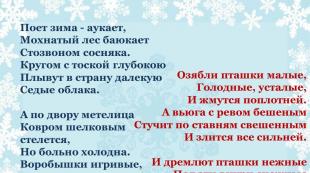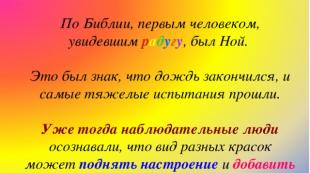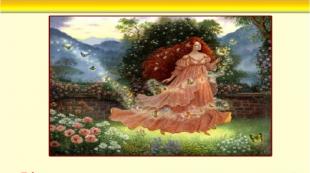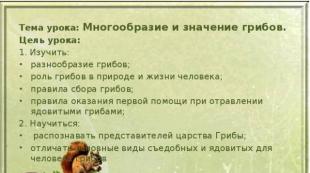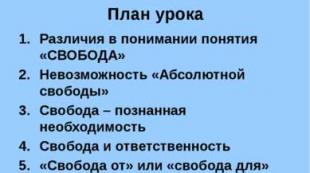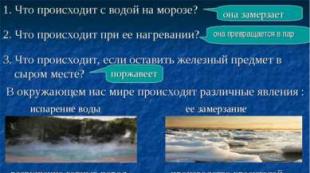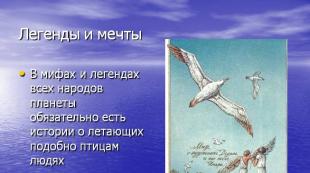Pages of the history of the XIX century. Pages of the history of the 19th century Page of the history of the 19th century the world around
Slides: 1. 1800 - 1899.
2. Storm of 1812.
3. Photo of Napoleon
4. Photo of Kutuzov.
5. Painting "Crossing the Neman".
6. View of the Battle of Borodino.
7. Painting "Council in Fili".
8. View of the Moscow fire.
9. Cathedral of Christ the Savior 1883
10. Cathedral of Christ the Savior 1996
11. Pictures from the life of serfs.
12. Manifesto - a solemn written appeal of the supreme authority to
people. S. I. Ozhegov.
13. Portrait of Alexander 11 - the king - the liberator.
Board decoration:
- Pages of history of the 19th century.
- The word "serf"
- Figures of a peasant of the 19th century and a landowner.
- Field image.
- Image 2 ropes
- Words: beat, sell, exchange, lose.
- Words: serve, work, pay.
- The word Manifesto.
- Words: you can not beat, sell, exchange;
conclude contracts,
acquire property,
get married,
handle cases in court;
the land is the property of the landowner;
serve a duty.
10. Numbers for indicating the date: 19. 02. 1861.
material for children:
- Test options.
- Rebus, to define the word "manifesto".
- Examples for determining the date
- Excerpts from the document.
The purpose of the lesson: acquaintance with historical figures who played
an important role in the history of Russia;
Lesson objectives:
- Educational - the formation of skills and abilities to work with historical documents;
- Developing - to orient students to the study of the historical events of our country;
- Educational - to cultivate love for the Motherland, interest in the historical past of their people.
1. Safety talk during the lesson.
- 2. Organization of the beginning of the lesson.
(on the date screen: 1800 - 1899)
Read the topic of today's lesson. (Pages of the history of the 19th century).
By the beginning of the 19th century, the territory of Russia stretched for thousands of miles from the Baltic Sea to the Pacific Ocean. Today we will talk about what life was like on this vast territory in those years far from us.
- 3. Verification homework.
(on the screen the words "Thunderstorm of 1812")
And the first thing I want to ask you is what the words "Thunderstorm of 1812" mean.
(this year the Russian army defended the independence of its
countries at war with the French army under the command of
Napoleon).
- Group work.
I suggest that each group (3 people) take a piece of paper with questions and, after consulting with each other in the group, choose the correct answer.
1 option
1. In France, in the 18th century, a commander came to power: a) Bagration
b) Napoleon
c) de Tolly
2. The French army invaded Russia in: a) 1821
b) 1818
c) 1812.
3. What decision did Kutuzov make after the Battle of Borodino:
a) leave Moscow
b) give another battle
c) recognize Napoleon as the winner.
4. In honor of the victory over Napoleon was built:
a) Peter and Paul Cathedral
b) Cathedral of Christ the Savior
c) Spaso-Preobrazhensky Cathedral.
Option 2.
1. The commander-in-chief of the Russian troops was appointed:a) M. I. Kutuzov
b) A. V. Suvorov
c) F. F. Ushakov.
- Why did Napoleon decide to leave Moscow?
a) for further advancement deep into Russia
b) due to the fire of Moscow
c) for the decisive battle.
- The War of 1812 is called the Patriotic War because:
a) the main battle took place near Moscow
b) all the people went to war
c) Napoleon's invasion brought Russia huge
disasters.
- Test check.
(questions from the first and second options are checked alternately)
1var . (on-screen photo of Napoleon)
Napoleon came to power in France in the 18th century. Napoleon
Bonaparte dreamed of military victories as a child. At 24 he became
general. Having become famous for several successful campaigns and having on his
to the side of the army devoted to him, Napoleon became Emperor of France.
2 var. (photo of Kutuzov on the screen)
M. I. Kutuzov was appointed commander-in-chief of the Russian troops -
illustrious commander, student and comrade-in-arms of Suvorov. Kutuzov was
one of the founders of Russian military art. He loved unconditionally
Russia and believed in the strength of his people. In a difficult hour for Russia, he was
appointed commander of the Russian troops.
1 var. (the picture “Crossing the Neman” is on the screen)
In 1812, Napoleon's troops crossed the borders of Russia. Emperor
The French dreamed of subjugating Russia. He counted on a quick and
easy win. According to Napoleon's plans, after several battles, Russia
should have asked for peace.
2 var. ( panorama of the Battle of Borodino on the screen).
battle. At half-past five in the morning, guns began to speak on the Borodino field.
One of the most difficult moments of the battle was the defense of the Kurgan height
Its defenders were led by General Nikolai Nikolaevich Raevsky. Both armies
suffered huge losses, but not a single one managed to win.
1 var. (the picture “Council in Fili” is on the screen).
After the Battle of Borodino, Kutuzov decided to leave Moscow.
in which all the top generals were present. Kutuzov raised the question
whether to give another battle near Moscow or to retreat without a fight.
After listening to both sides, of which one was in favor of retreat, and the other
against Kutuzov ordered to retreat. Defend Moscow and take risks
army was dangerous, because in case of failure with the destruction of the army
not only Moscow, but all of Russia would find itself in the power of the enemy.
“With the loss of Moscow, Russia is not yet lost,” Kutuzov said.
2 var. (on the screen "Fire of Moscow").
Napoleon decided to leave Moscow because of the fire. Not long French
stayed in Moscow. There was nothing to eat, it was cold, there was nowhere to live: terrible
The fire destroyed more than half of the houses. The French forces were fading and the enemies
left Moscow.
1 var. (view of the Cathedral of Christ the Savior in 1883 on the screen;
1996).
laying the foundation stone of a grandiose temple. It was consecrated in 1883. Honored guests
Veterans of the Patriotic War were in the temple. Each one hung on his chest
George Cross. But in 1931 the Cathedral of Christ the Savior was blown up.
In 1996, it was again restored with the money of the people.
2 var . (view of the Cathedral of Christ the Savior on the screen)
The War of 1812 is called the Patriotic War because the fight against
all the people rose up as enemies. Napoleon's invasion brought Russia
countless disasters, cities and villages were destroyed, many died
values. But Russia managed to defend its independence. How many times
it was in Russian history, all the people again rose to the defense
Fatherland. Therefore, in the history of Russia, the war of 1812 remained under
the name of the Patriotic.
4. Life of serfs in Russia.
(on the screen the words "Life of peasants in Russia").
Ordinary people who defended the country in the war with the French lived extremely hard. Remember what the life of the peasants was like at that time.(story of children to accompanyslides from the life of serfs)
The peasants have lost their freedom. They couldn't live the way they wanted
do what they like. Their lives depended entirely on
the owner, who could sell them, donate them, lose them at cards. More
during the time of Catherine 11 in the newspapers one could read such
ads:
"Sold small 17 years old and furniture."
“For the departure, a horse is sold, two maid girls.”
Such peasants were called serfs.(the word serf on the board).Let's remember what this means. Choose related words for the word serf.
Fortress, fasten, fasten,
fixed, strong.
At that time, serfdom existed in Russia. What are these orders?
Serfdom is a law under which the majority
Russian peasants could not leave their landlords.
Collecting the picture: on the one hand, according to the laws of serfdom, peasant
was attached to the landowner . By the same laws, the earth
belonged to the landowner, and had to work on it
peasant
The landowners did whatever they wanted with their serfs: they assigned them overwork, for the slightest offense they gave them to the soldiers, they flogged them - sometimes to death. Peasants were sold, separating children and parents, exchanged for dogs(cards with words attached to the picture).
Of course, the peasants did not like such a life. After the Patriotic War of 1812, many of them hoped for release. But this happened only with the coming to power of Alexander 11.
(MOVE TABLES)
5. The abolition of serfdom.
(portrait of Alexander 11 on the screen)
What was Emperor Alexander 11 like?
1) Messages from children about Alexander 11:
in 1825, he was proclaimed heir to the throne, and another year
later Vasily Andreevich Zhukovsky was hired
mentor of the heir to the throne.
“Dominate not by force, but by order,” the poet instructed
future king. “Love your people: without love for the people there is no love
people to the king.
2) - The name of Alexander 11, who ascended the throne in 1855, is associated with many changes in the life of the country. He decided to free the peasants from serfdom, and publishes a special document. And what it is called, you will find out by replacing each number in the row with a letter, and reading the resulting word.
(each number corresponds to a letter of the alphabet)
14 1 15 10 22 6 19 20
M A N I F E S T
(on the screen - the definition of the word "Manifesto")
What does the word "manifesto" mean?
In the dictionary of S. I. Ozhegov: Manifesto - a solemn written
appeal of the supreme power to the people.
-
I continue to create a picture: the word MANIFEST is attached below.
Replace the definition on the screen with the picture "Reading the Manifesto to the Peasants".
- - And now I suggest you find out when Alexander 11 signed the Manifesto. To do this, you need to solve examples and name the results.
(children in groups solve examples, a date is obtained from the answers and is attached to the board in a picture, under the word Manifesto)
96: 12: 2 + 15 (78: 13) - 5 (17: 1) =
1 8 - 7: (15: 15) - (21 - 21) 5 =
24: 2 3: 18 - (78: 39 - 584 0) =
2 (729 - 728) + (27: 3 + 6) - 45: 3 =
375 0 + 294: 294 - (16 - 16) : 2 =
(17 + 43) : 2 + 9 8: 4 - 5 (64: 8) =
125 0: (45 4) + (120 10: 100 - 6) =
(84: 14 5 - 15) : (91: 7 5 - 50) =
Validation: composing the date.
Table 1: - from the answers received, make a two-digit number in which the number
tens less than units (19)
(Attach the number 19 on the board under the word MANIFESTO.)
Table 2: - Arrange the received answers in ascending order (02)
(attach to board 02)
3 table: - from the results obtained, make a number in which the number
units more quantity tens (18)
(pin the number 18 on the board)
Table 4: - arrange the results in descending order (61)
(Put the number 61 on the board.)
6. Working with the document.
1) - And now I suggest you work with this historical document. You have sheets on your tables on which certain provisions from the 1861 Manifesto are printed. Read, consult with each other in your group and decide what is most important in these lines.
a) Serfdom for peasants settled in landlord estates,
and on the yard people is canceled forever.
(this means that now the peasant cannot be beaten, sold,
exchange; put the words on the board
b) Based on this provision and general laws, peasants and
yard people who came out of serfdom,
granted the rights of free citizens.
(this means that the peasants now have the right: to conclude agreements,
acquire property, marry, conduct business in court; the words
attach to board)
c) The landlords, while retaining the right of ownership to all the lands belonging to them, provide the necessary amount of field land for the permanent use of the peasants for the established duties.
(the land remained the property of the landowner;
attach words to board)
d) Peasants for the allotted plots of land are obliged to serve in favor of
landowners duty work or money.
(peasants are obliged to continue working for the landowner for the land -
serve a duty;put the words on the board
2) Generalization according to the picture drawn up on the board.
Let's now, looking at the picture that we got, let's try to conclude what has changed in the life of the peasants with the adoption of the document that they have been waiting for.
Peasants ceased to be the property of the landlord, they could not be bought, donated or sold. They received civil rights: they could independently conclude contracts, acquire property, and conduct court cases. But having received civil and personal freedom, the peasants did not receive the most important thing - land. Just as before, the land remained the property of the landowner, and the peasants, in order not to die of hunger, had to work for him.
7. Conclusion.
(on the screen photo of Alexander 11 with the inscription Tsar-Liberator)
But despite the shortcomings of the Manifesto, Alexander 11 entered Russian history as the tsar-liberator. He carried out a reform in the army, which replaced the recruitment (25 years) with universal military service. The service life has been reduced to 6 years. Education has been widely developed - more than 20 thousand educational institutions have appeared. A thaw also came for the press: more than 700 newspapers and magazines appeared.
In the second half of the 19th century, technical innovations appeared - electric lighting, Railway, telephone. At home I suggest you find additional material and prepare reports on the technical innovations of the 19th century.
1. Decembrists.
2.Liberation of the peasants.
3. Petersburg and Moscow.
1. Decembrists.
After the Patriotic War of 1812 in Russia, many hoped for change. The peasants who defended the country from enemies dreamed of liberation from forced labor.
Officers-nobles who participated in the Patriotic War of 1812 advocated a consecrated Russia, free from tsarist arbitrariness and serfdom. Secret organizations of future Decembrists were created in Russia.
December 14, 1825 (hence why they were called Decembrists ) in St. Petersburg members of one of the secret societies led on Senate Square troops. However, no one supported the speech. By evening, the uprising was crushed. The Decembrists were the first Russian revolutionaries. 121 Decembrists were put on trial, severe punishment awaited them.
2.Liberation of the peasants.
Serfdom - laws according to which the majority of Russian peasants could not leave their landlords. According to these laws, the land belonged to the landlords, and the peasants had to work on it.
The number of "souls" - male peasants (women were not considered "souls") from the landowner determined his wealth. The landowners did whatever they wanted with their serfs. The landowners could sell them, exchange them even for a dog, lose at cards. They put the hardest work on them, whipped them - sometimes to death.
Among the serfs were wonderful artists, musicians, sculptors. It is difficult to count how many talents perished in captivity.

Many years have passed since Decembrist uprisings before the serfs got their freedom. In 1861, Tsar Alexander II signed a manifesto on peasant liberty. On the same day it was read in churches throughout the Russian Empire.
From now on, all the inhabitants of Russia could arrange their lives themselves. However, as before, the opportunities for this were different for everyone. A different fate awaited a child from a family of a wealthy landowner, manufacturer, merchant and a child from a family of former serfs.

Into Russian history Alexander II logged in as liberator king.
3. Petersburg and Moscow.
After the liberation, the peasants rushed to the cities to earn money. The population of cities grew, many new factories and factories arose. The Putilovsky and Baltic factories were built in St. Petersburg. In Moscow, textile manufactories - Trekhgornaya and Danilovskaya - produced wonderful fabrics. Buildings of banks, department stores, theaters, and museums appeared in the center of Moscow and St. Petersburg.
Next to factories and factories, barracks for workers were built, in which the urban poor rented "corners" and "beds". Not everyone could afford to have their own little room.
Soldiers began to serve in the army for 6 years instead of the previous 25. Education was developed. There were new public schools and women's educational institutions.
4. Technical innovations of the XIX century.
City life was changing in Moscow and St. Petersburg. The streets were first lit with kerosene lamps, and later with gas lamps. At the end of the 19th century, electric lighting appeared.
From the second half of the 19th century, Russia was covered with a network of railways. This was of great importance for the successful development of the country's economy. At the end of the century, the construction of the Trans-Siberian Railway began. It connected the center of the country with Siberia and the Far East.

Urban transport has also changed: a horse-drawn railway (horse-drawn railway) appeared in St. Petersburg and Moscow.

HISTORY PAGES OF THE XIX CENTURY
Goals:
1. To form students' ideas about life in the 19th century.
2. Introduce the reforms of Alexander II.
3. To form students' ideas about technical inventions in the 19th century.
4. Develop an interest in history.
Equipment: portrait of Alexander II, historical map Russia in the 19th century.
During the classes
I. Organizing time. The topic of the lesson.
Teacher. This puzzle will help us to know the topic of the lesson.
Students. Freedom.
Teacher. Today in the lesson we will learn when the serfs became free. Let's walk through Moscow and St. Petersburg - from the center to the outskirts. Let's get acquainted with the technical innovations of that time.
II. Checking homework.
The teacher conducts a question:
– Why is the War of 1812 called the Patriotic War?
– Which commander commanded the Russian troops in 1812?
– Tell us about the Battle of Borodino using the textbook illustration.
If the statement is correct, then students put a “+” sign; if false, then the sign "-".
1. In France, the commander Bagration came to power.
2. The French army invaded Russia in 1812.
3. Kutuzov was appointed commander-in-chief of the Russian troops.
5. After the battle of Borodino, Kutuzov decided to leave Moscow.
6. The War of 1812 is called the Patriotic War because the whole nation rose to the war.
7. In honor of the victory over Napoleon, the Kazan Cathedral was built in Moscow.
8. In St. Petersburg is the tomb of Kutuzov in the Peter and Paul Cathedral.
9. After the end of the Patriotic War of 1812, a monument to Minin and Pozharsky was erected in Moscow on Red Square.
Answers: –, +, +, –, +, +, –, –, +.
Students submit their work for review.
III. Working on new material.
Teacher. Valiant defenders, peasant partisans, hoped that their position in the country would change, but this did not happen. After the war, the landlords increased the corvée and dues. Yesterday's partisans murmured: "We shed blood, delivered Russia from a tyrant, and the lords tyrannize us again."
What is serfdom? What was the life of the peasants at that time?
Students. The peasants were serfs. Their life depended on the owner, who could sell them, donate them or lose them at cards.
Teacher. Did the peasants put up with such a life?
Students. They raised uprisings. Emelyan Pugachev gathered around him a huge number of dissatisfied people and became the leader of the uprising.
Teacher. Serfdom is a law according to which the majority of Russian peasants could not leave their landlords. According to the laws, the land belonged to the landlords, and the peasants had to work on it. The wealth of the landowner was determined by how many "souls" he had - male peasants (women were not considered "souls"). There were landowners who had several thousand "souls". Peasants attached to the landed estates were called serfs.
The landowners did whatever they wanted with their serfs: they assigned them overwork, for the slightest offense they gave them to the soldiers, they flogged them - sometimes to death. Peasants were sold, separating children and parents, bartered for dogs.
The poet K. F. Ryleev wrote:
Ah, I'm sick of
And in native side:
All in trouble
In hard times...
How long is the Russian people
Will junk gentlemen?
After the Patriotic War of 1812, many hoped for the liberation of the serfs. But this happened only in 1861, when Tsar Alexander II signed a manifesto on peasant freedom, for which he was called the liberator.
On March 30, 1856, Alexander II delivered a speech to the Moscow nobility: “It is better to abolish serfdom from above than to wait for the time when it will itself begin to be abolished from below.” There were good reasons for such a statement. Most of the Russian peasants survived from bread to kvass.
Read the text on p. 122–123 of the textbook. Why did Alexander II enter Russian history as the tsar-liberator?
Students. He signed a manifesto on peasant liberty.
Teacher. The name of Alexander II is associated with many changes in the life of the country. Cities developed, factories and factories appeared, new railways were built. New educational institutions were created. Alexander II carried out other important reforms. His reign for Russia was progressive. Zemstvos were created - local elected bodies. Trials were now adversarial, with lawyers and jurors. Education was developed: almost 20 thousand public schools appeared under Alexander II, up to 300 women's educational institutions. A thaw also came for the press: more than 700 newspapers and magazines appeared. The social movement gained wide scope. The territory of Russia itself has increased by 355,000 square meters. verst.
Despite this, the personal fate of Alexander II was tragic. Since 1866, several attempts were made on his life, from one of them he died on March 1, 1881.
Students read the article "Petersburg and Moscow" on p. 123-124 of the textbook and fill in the diagram:

In the morning the children woke up
Smiled, stretched
Quickly charged:
Handles up, handles down
Got up on tiptoes
Bent over on the side
On toes, hop-hop-hop.
Teacher. New times have come in the life of the country. What technical innovations appeared in the 19th century? Read the article on p. 124-125 of the textbook "What technical innovations have entered people's lives."
Students. In the 19th century, electric lighting, the railway, and the telephone appeared.
Teacher. Look at the map on p. 120–121 of the textbook. Find the Trans-Siberian Railway. What cities does it go through?
IV. Consolidation of what has been learned.
The teacher conducts a conversation on the questions:
– When did the serfs get their freedom?
– What did it matter?
– When did the first railroad appear?
– What cities did she connect?
– What t trans-siberian highway?
The teacher prepares 3 sets of cards in advance. Cut into rectangles along bold lines.
Generalissimo
The class is divided into 3 teams. The team that completes the correct chain of Domino cards the fastest wins.
Summing up the game.
V. Summary of the lesson. Grading.
Students read the output on p. 126 textbooks.
Homework.
pp. 122–126. Answer the "Check Yourself" questions.
Lesson summary:"The world around" 4th grade.
Lesson topic:"Pages history of the XIX century"
Lesson type: learning new material.
The purpose of the lesson: the formation of students' ideas about life in Russia in the 19th century.
Educational:
To form students' ideas about life in the 19th century.
To acquaint with the reforms of Alexander II.
To form students' ideas about technical inventions in the 19th century.
Developing:
Develop oral speech.
Develop the ability to draw conclusions, generalize.
Educational:
1. Raise interest in history.
2.Educate moral qualities personality.
Formation of UUD:
Cognitive UUD
the ability to carry out logical actions;
ability to compare, analyze, generalize, reason.
ability to work with a map.
Communicative UUD:
the ability to formulate one's thoughts orally; listen and understand the speech of others;
the ability to participate in a collective discussion of an educational problem;
the ability to exchange opinions; build speech statements that are understandable for everyone in communication; ask questions to get the information you need.
Regulatory UUD:
the ability to determine and formulate the goal in the lesson with the help of a teacher;
the ability to organize your workplace under the guidance of a teacher;
the ability to express one's assumption (version) on the basis of working with an illustration;
the ability to make the necessary additions, corrections to their work, if it diverges from the model;
goal-setting as setting a learning task based on the correlation of what is already known and learned by students, and what is still unknown.
Personal UUD:
perform self-assessment based on the criterion of success of educational activities.
Planned results:
Subject:
create an image of Emperor AlexanderII;
to form students' ideas about technical inventions in the 19th century.
to form students' ideas about life in the 19th century.
Metasubject:
improve the ability to use previously acquired knowledge in work and draw conclusions;
develop cognitive interest and creative activity, speech;
create conditions for the formation of the ability to interact with peers;
extract and analyze information from textbook illustrations;
establish causal relationships.
Personal:
formation of positive motivation for learning.
manifestation of the foundations of civic identity - a sense of pride in the Russian people and the history of Russia.
determine the personal meaning of the doctrine.
Equipment:
textbook "The world around" grade 4, part 2, author A.A. Pleshakov., E.A. Kryuchkov.
electronic supplement to the textbook of the world around A. A. Pleshakov., E.A. Kryuchkov.
Concepts: Patriotic War, Napoleon Bonaparte, the village of Borodino, Denis Davydov, Cathedral of Christ the Savior, Decembrist, manifesto.
Equipment: presentation, textbook World around 4 cells, part 2, A.A. Pleshakov.
multimedia installation, computer, presentation for the lesson.
sheets for performing graphic dictation.
electronic supplement to the textbook of the world around A. A. Pleshakov.
| Stages and methods | Time | Teacher activity | Student activities | Results: formed UUD |
| I . Organizing time. | Hello guys! Guys, at the beginning of our lesson, give a smile to each other, wish your friend a good working mood for the whole school day. | Greet the teacher, check the readiness for the lesson. | TO. - follow the rules of speech behavior, ask questions, listen and answer questions. |
|
| II . Knowledge update verbal method. Practical. Blitz poll. Practical. Pair work. | 1. Blitz (checking homework) In what year did World War II start? What country attacked Russia? Why did Napoleon attack different countries? Who was appointed commander in chief of the Russian troops? Where did the Battle of Borodino take place? Why did the Russian military decide to leave Moscow? What was going on in Moscow when the French entered? Who was the commander of one of the partisan detachments? 2. TestOption 1 1. In France in the XVIII century. commander came to power a) Bagration b) Napoleon c) de Tolly 2. The French army invaded Russia in: a) 1821 b) 1818 c) 1812 3. In honor of the victory over Napoleon was built: a) Peter and Paul Cathedral b) Cathedral of Christ the Savior c) Spaso-Preobrazhensky Cathedral 4. After the end of the Patriotic War of 1812, a monument was erected in Moscow on Red Square: a) Minin and Pozharsky b) Peter the Great c) Catherine II Option 2 1. The commander-in-chief of the Russian troops was appointed: a) M.I. Kutuzov b) A.V. Suvorov c) F.F. Ushakov 2. The Battle of Borodino took place: 3. What decision did Kutuzov make after the Battle of Borodino? a) leave Moscow b) give another battle under the walls of Moscow c) recognize Napoleon as the winner 4. The War of 1812 is called the Patriotic War because: a) the main battle took place near Moscow b) all the people went to war c) Napoleon's invasion brought great disasters to Russia. Mutual verification. Look at the photographs to remember the event captured on it and see under what number the date is written. Development of St. Petersburg. 1703 Baptism of Russia. 988 Battle on the Ice. 1242 Battle of Borodino. 1812 Kulikovo battle. 1380 What event is associated with 1480? (Fall of the Horde yoke. Battle on the river Ugra. Akhmat) What happened in 1861 | Anwser the questions. Run a quiz and test | P. - R. - To carry out control according to the sample - mutual verification. TO.- work in pairs. |
|
| III . Statement of the educational problem and its solution verbal method. Dialog. Practical. Practical. Group work. | (Words on the board: Decembrist, serf, horse-drawn carriage, manifesto, manufactory, Trans-Siberian Railway.) Explain the meaning of these words. (Children's statements.) Where can we find the meaning of these words? (Children's answers.) We will learn about these words in class. Theme of the lesson: "Pages of the history of the XIX century." What is the purpose of the lesson in relation to the topic? What are we going to do to achieve this goal? What would you like to know about this topic? Formulate your questions. (The teacher writes the questions on the blackboard.) Physical education minute | State your guess. Anwser the questions. Determine the topic, goals and objectives of the lesson. Conduct a physical session. | P. - be aware of the cognitive task, make generalizations, conclusions; extract information from diagrams, illustrations; TO. - |
|
| front poll. Practical. Work with the textbook and additional sources. Practical. Map work. Working with CD Viewing a presentation. | - Let's repeat the rules of working in a group. Serfdom - the laws by which the majority of Russian peasants could not leave their masters - the landowners. According to these laws, the land belonged to the landlords, and the peasants had to work on it. The wealth of the landlord was determined by how many "souls" he had - male peasants (women were not considered "souls"). There were landowners who had several thousand "souls". Peasants attached to the landed estates were called serfs. The landowners did whatever they wanted with their serfs: they assigned them overwork, for the slightest offense they gave them to the soldiers, they flogged them - sometimes to death. Peasants were sold, separating children and parents, bartered for dogs. There were excellent artists, musicians, sculptors among the serfs. All of them were as dependent on the landowners as those who worked in the fields. Beautiful works of art created by the hands of serfs. Unfortunately, the talents of many perished in serf captivity. There were laws forbidding landlords to mistreat serfs, but they were poorly enforced. After the Patriotic War of 1812, many hoped for the liberation of the serfs. But this happened only in 1861, when Tsar Alexander II signed a manifesto on peasant liberty. For which he was called the Liberator. 1. Working with the map Using the map in the textbook, complete the task on p. 125. (Students work with the map in the textbook and at the blackboard.) 2. Completing tasks in the workbook Set the sequence of events by doing task 1 on p. 42. (1. The Decembrist uprising. 2. The opening of the railway between St. Petersburg and Moscow. 3. The liberation of the serfs. 4. The beginning of the construction of the Trans-Siberian Railway.) (Students compare 2 documents (pp. 125-126 of the textbook), express their opinion.) 3. Working withCD (View presentation.) | Tell messages. Complete the tasks in the workbook. Listen to the teacher Answer teacher's questions View presentation. | TO. - follow the rules of speech behavior, ask questions, listen and answer the questions of others, build a speech statement in accordance with the tasks; R.- understand the prospects for further academic work, determine the goals and objectives of the assimilation of new knowledge; |
|
| IV . Lesson summary Reflection verbal method. Homework. | What knowledge have we discovered? Have we achieved our goal? (Children's statements.) Let's go back to the words on the board. Explain now the meaning of these words. Have we answered all the questions posed at the beginning of the lesson? (The teacher draws the attention of the children to the board where the questions are written.) Compose a synquay on the topic of the lesson. Reflection What did you do well in class? What else needs to be worked on? Who in your group would you like to thank for the lesson? (Self-assessment. Teacher's comment.) 2. Complete tasks 2, 4 on p. 42-43 of the workbook. | Tell your opinion. Conduct reflection. Record d / z | TO. - ask questions, build a speech statement in accordance with the tasks; |
Lesson on the topic: "Pages of the history of the XIX century"
Goals:
To acquaint with the reforms of Alexander II.
To form students' ideas about technical inventions in the 19th century, to develop interest in history.
Cultivate patriotism, respect for history
Equipment:
name cards famous people,
a computer,
projector,
slide program.
timeline,
portrait of Alexander II,
Lesson type: assimilation of new knowledge
During the classes
I. Organizational moment.
II. Repetition of the studied material. The topic of the lesson.
Before us is the book “History of Russia. 19th century". ( Appendix 1(slide 1))
In the last lesson, you already learned about one important event at the beginning of this century.
Would you like to turn the pages of this book further? Why do you want to do this?
The 19th century was full of various events in the political and cultural life of the country. You will meet them in high school.
Today, turning over just a few pages of this book, you will learn:
about the new king;
about a number of his reforms;
about some inventions of the 19th century.
Do you want to know about it?
Then try fast
Complete all tasks.
You have a card on the table. ( Annex 2)
Read what is written on it. (Catherine II, Michael Illarionovich Kutuzov, Peter I, Ivan III, A.V. Suvorov, Ivan the Terrible).
What is written? (names of famous people)
What 2 groups will you divide these names into? (rulers of our country and commanders).
What unites Suvorov and Kutuzov? (Suvorov - Generalissimo - the highest military rank in the Russian army. Died 1800Kutuzov - Commander-in-Chief of the Russian Army).
fought the French troops.
Kutuzov was a student of Suvorov.
they have the same fate. The tsars removed them from the army when there were no wars, and called them up again when Russia was in danger.
What danger threatened Russia in 1812? (The French army invaded to "...crush" Russia).
M.Yu. Lermontov has the following lines:
No wonder the whole of Russia rememberswhiteboard writing
About the day of Borodin!
Why do you think all of Russia remembers this day? (Losses up to 50 thousand in this terrible battle).
(Napoleon wrote: “Of all my battles, the most terrible one was the one I gave near Moscow. The French showed themselves worthy of victory in it, and the Russians acquired (got, acquired) the right to be invincible.”
Tell us about the Battle of Borodino using the diagram.
Battle of Borodino.
On August 22, 1812, the Russian army deployed along the Kolocha River near the village of Borodino, about 110 km from Moscow. There were about 120 thousand people in the Russian army, about 30 thousand more people's volunteer militias, who were used to build fortifications and as orderlies, and more than 600 guns. Napoleon had about 135 thousand people and a little less than 600 guns.
All day the parties prepared for battle.
The battle began on August 26 at 5:30 am. Several attacks were repulsed with heavy losses for the French. But, nevertheless, the enemies manage to capture the village of Borodino. The most difficult moment of the battle was the defense of Kurgan height. Its defenders were led by General N.N. Raevsky.
For several hours, 400 French guns fired at the height. 45 thousand French against 18 thousand Russians. Nevertheless, after fierce attacks, the enemy managed to take the height. Russian troops withdrew behind the village of Semenovskoye and continued to hold the line.
Both the Russians and the French suffered heavy losses. After dark, the French troops withdrew to their previous positions. The Russians remained in place, not trying to retake the lost fortifications.
By order of Kutuzov, the Russian army retreated to Moscow.
Kutuzov: "With the loss of Moscow, Russia has not yet been lost ...".
III. Learning new material.
1. - And now we are waiting for the game: "Unsent dispatch". ( Dispatch- written communication).
There is a written message on the cut card. Find out who sent it.
| CatherineII | A.V. Suvorov | |
| Peter I | Ivan the Terrible | "Sea ships to be!". |
| M.I. Kutuzov | Ivan III |
Examination. Turn over the cards. If you get a portrait, then the task is completed correctly. ( Appendix 1(Slide 3))
Whose portrait did you get? (Portrait on the board) (Appendix 4)
The figure of Alexander II is interesting. When he was still a child, his father, Emperor Nicholas I ( Appendix 1(slide 4)), invited the famous poet Vasily Andreevich Zhukovsky to become the tutor of the little heir. The instructions that the poet tried to instill in his pupil have come down to us: “Love your people: without the love of the king for the people, there is no love of the people for the king.” Alexander II ascended the Russian throne in 1855 at the age of 36. (1855-1881)
He traveled a lot in Russia and was the first of the royal family to visit Siberia. In the eyes of many, he was kind and just.
2. - This puzzle will help you find out what Tsar Alexander II was called. ( Appendix 1(slide 6.7))
Whom and from what did he free?
will help you keyword from a crossword puzzle that the guys were solving.
A word to the inspector: how they coped with the task.
What was the keyword? (Peasants).
What was the life of the peasants like?
What do you think the tsar freed the peasants from? (From serfdom).
What is serfdom? What was the life of the peasants at that time? (Serfdom is a law according to which the majority of Russian peasants could not leave their landlords).
Why do you think it was necessary to abolish serfdom?
A) shameful and humiliating order.
B) For many centuries, serfdom was a brake on the development of the country. The bulk of the population were peasants.
C) On March 30, 1856, Alexander II delivered a speech to the Moscow nobility: “It is better to abolish serfdom from above than to wait for the time when it will itself begin to be abolished from below.”
There were good reasons for such a statement. Most of the peasants survived from bread to kvass.
Appears on the board:
Reforms - the abolition of serfdom
Alexander II
(portrait)
IV. Fizkultminutka.
Look at the "Historical Events" timeline. (On the desk).
The timeline records the years when famous events took place in our country.
Do you know all the years recorded on the tape? (No. 1861).
What about the rest of the years? (Yes).
Let's play a game: "Compare the events with the date." (Children get up) You will need to remember the event captured on it from a drawing or photograph and see under what number the date is written. (Children complete the task as many times as the given number indicates)
(Appendix 1(Slides 9-13)).
Development of St. Petersburg. 1703 (4) – right hand up, hand jerks
Baptism of Russia. 988 (1) – hands to the sides, clap above the head
Battle on the Ice. 1242 (2) - jumping
Battle of Borodino. 1812 (5) - slopes
Kulikovo battle. 1380 (-) - squat
What event is associated with 1480? (The fall of the Horde yoke. The battle on the river Ugra. Akhmat).
V. Learning new things.
1) - What happened in 1861? ( Appendix 1(Slide 14)).
Read the article "The Liberator Tsar" on page 122 and you will find the answer to this question. (Signed manifesto- a written appeal of the supreme power to the people. The manifesto of February 19, 1861 granted the peasants personal freedom).
Russia has stopped human trafficking. “You were all someone else’s, and now, thank God, you have become your own,” the peasants said to each other.
2) - Many changes in the life of the country are connected with the name of Alexander II. appeared and developed cities, the urban population began to grow rapidly.
What happened main reason urban population growth?
(Peasants move to the cities in search of a better life or take temporary jobs in the city).
appeared factories:
Mechanical (Appendix 1 (Slide 15))
engineering
metalworking
glass
cement (Appendix 1 (Slide 16 - plant and metalwork shop)).
textile manufactories (beautiful fabrics)
factories (confectionery, cloth) ( Appendix 1(Slide 16)) .
Alexander II paid great attention to education. Created new educational institutions . Created primary schools (Training period did not exceed 3 years), high school. Under Alexander II, more than 20 thousand educational schools arose, women's educational institutions appear (gymnasium).
More than 700 newspapers and magazines appeared.
Were created zemstvos - local elected bodies.
- Trials dealt with lawyers and jurors.
were built new railways . (Appendix 1(Slide 17 - Railway construction)).
(The 1st passenger railway opened in 1837 between St. Petersburg and Tsarskoye Selo).
The Trans-Siberian Railway was being built - the Great Siberian Way. ( Appendix 1(Slide 18 - Bridge across the Yenisei)).
Locate the Trans-Siberian Railway on the map. What cities does it go through?
Why did the construction of the railway have great importance?
The construction of the Trans-Siberian Railway made it possible to connect the center of the country with Siberia and the Far East.
- The development of new lands made it possible to begin the resettlement of peasants from the center of Russia.
Railways have become the most important mode of transport. Fast transportation accelerated the development of many sectors of the economy.
- Thanks to the Trans-Siberian Railway, the defense capability of the Far Eastern borders has sharply increased.
(Appendix 1(Slide 19 - locomotives, wagons)).
What other technical innovations appeared in the 19th century? Read the article on pages 124-125. (Electric lighting, telephone, horse-drawn railway - KONKA, trams, 1st a car(1899), the first Russian car with an internal combustion engine - worked on fuel (1896), elevators). ( Appendix 1(Slides 20-22)).
Mozhaisky Alexander Fedorovich ( Appendix 1(Slide 23)) from 1856 he worked on the creation of an aircraft. He studied the flight of birds, kites, conducted research. He was assigned a plot on a military field near St. Petersburg, where the construction of an aircraft with 2 steam engines and 3 propellers began. Mozhaisky's plane lifted a man into the air for the first time.
Appears on the board:
Many changes in the life of the country occurred during the reign of Alexander II. Despite this, the personal fate of this king was tragic. Several attempts were made on his life, from one of them he died on March 1, 1881 in St. Petersburg. (There were people who believed it was possible to change political system by killing unwanted rulers).
At the place where Alexander II was killed in 1907 at the direction of Alexander III (2nd son of Alexander II), the Church of the Resurrection of Christ was built. ( Appendix 1(Slide 25)). Multi-colored domes, stone patterns. The church is a tribute to the memory of the tsar, which is why they call it differently - the Savior on Blood. When the sun's rays fall on the red stone of its walls, it seems as if they are spattered with blood.
VI. Consolidation of what has been learned.
So we turned over some pages of the history of the 19th century. ( Appendix 1(Slide 26)).
Domino game
| Generalissimo | Alexander II | liberator | |
| First railroad | Catherine II | ||
| Abolition of serfdom | |||
| Patriotic War | F.F. Ushakov | naval commander | A.V. Suvorov |
What was the name of Alexander II?
Why did Alexander II enter Russian history as the tsar-liberator?
When did the serfs get their freedom?
What did it matter?
VII. Summary of the lesson. Homework.
Learn about technical innovations that appeared in the 19th century from additional literature.
Come up with a story about the fate of the family of former serfs after receiving the will.
Grading.
Catherine II,Michael Illarionovich Kutuzov , Peter I, Ivan III,A.V. Suvorov , Ivan the Terrible
Catherine II,Michael Illarionovich Kutuzov , Peter I, Ivan III,A.V. Suvorov , Ivan the Terrible
Catherine II,Michael Illarionovich Kutuzov , Peter I, Ivan III,A.V. Suvorov , Ivan the Terrible
Catherine II,Michael Illarionovich Kutuzov , Peter I, Ivan III,A.V. Suvorov , Ivan the Terrible
| CatherineII | A.V. Suvorov | "If I dare to say that serfs are people like us, then I risk losing the throne." |
| Peter I | Ivan the Terrible | "Sea ships to be!". |
| M.I. Kutuzov | Ivan III | “Well, how can one not beat the French with such good fellows ?!” |
| CatherineII | A.V. Suvorov | "If I dare to say that serfs are people like us, then I risk losing the throne." |
| Peter I | Ivan the Terrible | "Sea ships to be!". |
| M.I. Kutuzov | Ivan III | “Well, how can one not beat the French with such good fellows ?!” |
| CatherineII | A.V. Suvorov | "If I dare to say that serfs are people like us, then I risk losing the throne." |
| Peter I | Ivan the Terrible | "Sea ships to be!". |
| M.I. Kutuzov | Ivan III | “Well, how can one not beat the French with such good fellows ?!” |
| CatherineII | A.V. Suvorov | "If I dare to say that serfs are people like us, then I risk losing the throne." |
| Peter I | Ivan the Terrible | "Sea ships to be!". |
| M.I. Kutuzov | Ivan III | “Well, how can one not beat the French with such good fellows ?!” |
| Generalissimo | Alexander II | liberator | |
| First railroad | Catherine II | ||
| Abolition of serfdom | |||
| Patriotic War | F.F. Ushakov | naval commander | A.V. Suvorov |

